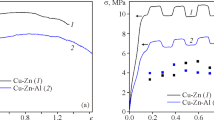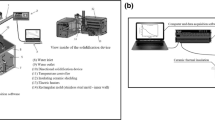Abstract
High temperature stress relief intergranular cavitation and subsequent room temperature embrittlement of an aluminium-bearingα-brass has been studied metallographically. The behaviour of a cast susceptible to cavitation has been compared to one which does not exhibit intergranular cavitation during stress relief, and which is subsequently more ductile at room temperature. A number of micro-analytical techniques (SIMS and EDX) failed to reveal any difference in the grain boundary chemistry between a cast susceptible to intergranular cavitation and one which was not, but it is suspected that the combined action of dissolved gases (e.g. hydrogen) and trace element impurities plays a major role in cavitation. The cavities formed during stress relief were often polyhedral in shape and it is considered that this occurs by the diffusion of matter around the cavity surface to attain a lower energy surface configuration. Second phase particles were found to play only a minor role in the nucleation of cavities. Room temperature intergranular fracture surfaces of material, in which cavities had formed during stress relief, were interpreted in terms of high temperature cavity formation and coalescence combined with low temperature plastic void growth and interlinkage.
Similar content being viewed by others
References
G.W, Greenwood, Proceedings of the 3rd International Conference on the Strength of Metals and Alloys, Vol. 2 (Cambridge, 1973) p. 91.
A.J. Perry,J. Mater. Sci. 9 (1974) 1016.
M. Rühle,Metall. 5 (1976) 416.
S. Sato andK. Sagisaka, Sumitoma Light Metals Technical Report (1968) P. 2.
S. Sato, T. Otsu andE. Hata,J. Inst. Met. 99 (1971) 118.
“Grain boundary cracking in metals under stress at elevated temperatures”,U.S. Office of Naval Research, Washington D.C., Contract No. 2613(00), June 15, 1961.
F.H. Wilson, Proceedings of the International Conference on Material Properties and Selection for Structural Design, 1973 (ASM, Metals Park, Ohio, 1974).
E. Eborall andH.J. Swain,J. Inst. Met 81 (1953) 995.
L. Hermonen, Maschinenmarkt Europa industrie revue2 (1969) 26.
L.J. Aschan, Internal report LAB 1490F, Gränges Metallverken, Västerås, Sweden (1964).
R.G. Fleck, D.M.R. Taplin andC.J. Beevers,Acta Met. 23 (1975) 415.
J.O. Steigler, K. Farrell, B.T.M. Lok andH.E. McCoy,Trans. ASM 60 (1967) 494.
B.J. Schulz andC.J. McMahon,Met. Trans. 4 (1973) 2485.
G.D. Joy andJ. Nutting, Proceedings of the Conference on Effect of Second Phase Particles on the Mechanical Properties of Steel (Iron and Steel Institute, 1971) p. 95.
W. Roberts, B. Lehtinen andK.E. Easterling,Acta Met. 24 (1976) 745.
D. Burns, D.W. James andH. Jones,Met. Sci. J. 7 (1973) 203.
B.F. Dyson andD. McLean,ibid. 11 (1977) 37.
Author information
Authors and Affiliations
Rights and permissions
About this article
Cite this article
Kjellsson, L., Svensson, L.E., Sundberg, R. et al. High temperature stress relief cavitation of an Al-bearing α-brass. J Mater Sci 13, 2441–2448 (1978). https://doi.org/10.1007/BF00808059
Received:
Accepted:
Published:
Issue Date:
DOI: https://doi.org/10.1007/BF00808059




